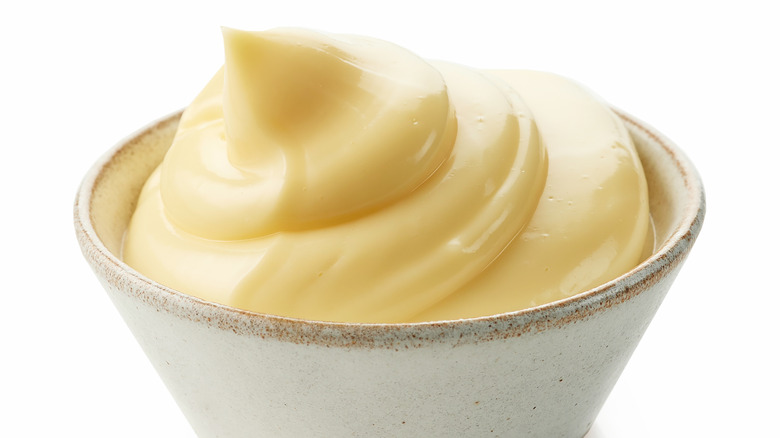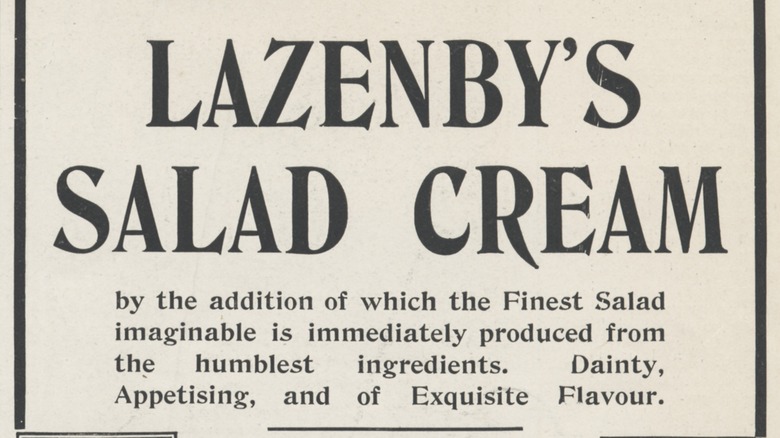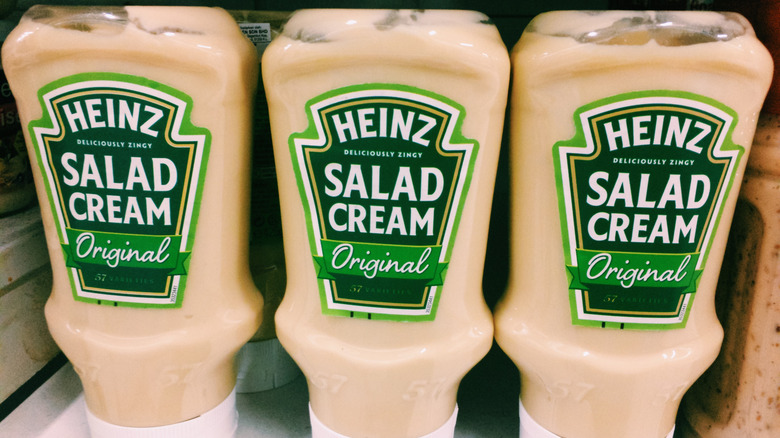Everything You Need To Know About Salad Cream
If you grow up in the U.S., you either do so in a mayonnaise or a Miracle Whip household ... and rarely do the twain meet. It's possible some homes utilize both, but culinary folk wisdom says they are few and far between. So, when you're served a tuna salad sandwich, it's coming bound by eggy, rich mayo or tangy, sweet Miracle Whip.
But for those across the pond in the U.K., there is yet another option in the creamy condiment category, one beloved by Brits: salad cream. I Heart Britain explains that the uses for salad cream are many and seemingly outpace the variety of uses Americans have for mayonnaise and Miracle Whip. In the U.K., it's not uncommon to see it applied to fried fish sandwiches, beans on toast, chip butties, fruit, even pizza.
So what's inside a bottle of salad cream and from whence does it come?
To boil dressing
Salad cream, as noted by Cooks Info, is a form of boiled dressing, a 19th century creation born out of Northern European countries' lack of access to affordable vegetable oil, such as olive oil, commonly used in vinaigrettes and mayonnaise. Knowing that egg yolks and vinegar will emulsify over light heat — as can be produced by a double boiler, hence the name — enterprising cooks created a substitute that also included a liquid like milk, cream, or water. Salt, sugar, mustard, and even the elusive olive oil were used to flavor boiled dressings.
It should be noted that boiled dressing is much thinner than either mayonnaise or Miracle Whip, and it likely is, or at least was, used more frequently than its culinary cousins as a topping for leafy salads. But it can also be found as a stand-in for mayonnaise and Miracle Whip in many recipes, particularly bound salads such as tuna, chicken, potato, and coleslaw.
A legend is born
How then did we get from boiled dressing to salad cream? We have those condiment kings at Heinz to thank, says The Nosey Chef. In 1914, they brought to the British market a bottled version of a creamy salad dressing already popular with Britons. An exhaustive history by U.K. newspaper The Independent further explains that salad cream was the first product Heinz created specifically for Great Britain, and it took a full eight years to perfect the sauce. It was a good thing they did, as World War II led to rationing that cut ketchup supplies short and didn't do any favors for the food that was left to go around. Zippy salad cream proved to be just what was needed to liven up the drab meals of wartime.
As the years progressed, salad cream — by now made by more companies than just Heinz, such as Crosse & Blackwell — saw its popularity ebb and flow as tastes changed. But along the way it worked its way into the hearts of Britons, much like Marmite and HP Sauce (via Food52.) That popularity didn't end at the shores of the British Isles either. It spread its way across the commonwealth nations, reports Vice, with Crown subjects across the globe, in places like Nigeria, Hong Kong, and the Falkland Islands, developing an affinity for salad cream.


